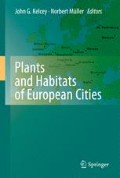Abstract
Maastricht, the birthplace of the Euro, is the southernmost city in The Netherlands. Thanks to its favourable position in the transition from a hilly loess and limestone area to a river valley, the city supports a rich flora and fauna. The earliest botanical records are from excavations of Neolithic and Iron Age sites in which the remains of cereals and weed species were found. A greater variety of food plants were found in the excavations of Roman sites. In recent times, 721 vascular plants (17% are neophytes) have been recorded in the city, of which 461 were recorded in the central area and 260 only in the outskirts. The St. Pietersberg (a limestone hill) and three man-made habitats (the Medieval walls, the fortifications and the limestone revetments of the river Jeker) are of special botanical interest. The old walls are the most botanically valuable urban habitat in the city, especially for vascular species and lichens, whilst the fortifications are a remarkable element in terms of bryophytes and grassland species. A substantial amount of effort is taken to preserve the ecological value of the old walls and fortifications and to enlarge the area of the flowering plants, which also encourage bees and butterflies.
Access this chapter
Tax calculation will be finalised at checkout
Purchases are for personal use only
Further Reading
Aptroot A, Van Herk CM (1999) Korstmossen in Limburg, voorjaarsweekend 1998. Buxbaumiella 49: 14–26
Bakels C, Dijkman W (2000) Maastricht in the first millennium A.D. – the archaeological evidence. Archaeologica Mosana II, Maastricht
Bakels C, Jacomet S (2003) Access to luxury foods in Central Europe during the Roman period: the archaeobotanical evidence. World Archaeology 34: 542–557
Bardet N, Jagt JWM (1996) Mosasaurus hoffmanni, le «Grand Animal fossile des Carrières de Maestricht»: deux siècles d’histoire. Bulletin du Muséum national d’Histoire naturelle 18(4): 569–593
Bonnemayer JJAM (1986) De Bossche Fronten. Cultuurhistorie en natuurhistorie hand in hand. Natuurhistorisch Maandblad 75: 4–9
Cortenraad J, Mulder T (1998) Actualisering van de lijst van bedreigde planten in Limburg. Natuurhistorisch Maandblad 87: 161–170
De Mars H, Verhulst H (2005) Een eeuw verdroging in het Jekerdal. Natuurhistorisch Maandblad 94: 227–231
De Wever A (1913) Lijst der wildgroeiende planten in Z.-Limburg III. Jaarboek van het Natuurhistorisch Genootschap in Limburg 1913: 1–73
Dortangs RW, Schulp AS, Mulder EWA, Jagt JWM, Peeters HHG, De Graaf DT (2002) A large new mosasaur from the Upper Cretaceous of The Netherlands. Netherlands Journal of Geosciences 81: 1–8
Frissen-Moors CMM, Tilmans RAM (2009) Muurhagedis Podarcis muralis. In: Creemers RCM, Van Delft JJCW (eds.) De amfibieën en reptielen van Nederland. Nederlandse Fauna 9. Naturalis, EIS, Leiden
Graatsma BG (2003) De flora van de omstreken van Maastricht in de 19e eeuw. Stichting Natuurpublicaties Limburg, Maastricht
Graatsma B, De Jong T (1995) ‘Onbekommerd’ in de voetsporen van Jac. P. Thijsse. CNME, Maatricht
Harle N (2008) Floristische rijkdom tussen stad en land. Natuurhistorisch Maandblad 97: 213–221, 225–231
Klasberg M, Bindels E, Breitkopf S (2009) Meerwaarde van de landschappelijke benadering van het project A2 Maastricht voor de waarde van groen en natuur. Groen 20/10: 20–27
Kruyntjens B (1994) De Hoge Fronten: restauratie, consolidatie en beheer in 1992 en 1993. Natuurhistorisch Maandblad 83: 154–163
Lejeune M (2002) De vegetatie van de Kleine Weerd (Maastricht) 1996–2000. Ruigte en co … of is er meer aan de hand? Natuurhistorisch Maandblad 91: 160–169
Nieuwkoop JAW (1996) Reboulia hemispherica L. Raddi terug in Nederland, met opmerkingen over de mosflora van de Hoge Fronten. Buxbaumiella 40: 37–40
Ramakers E (2005) Historische atlas van Maastricht. 2000 jaar aan Maas en Jeker. SUN, Amsterdam
Schaminée JHJ, Janssen JAM (2009) Europese Natuur in Nederland. Natura 2000-gebieden van Hoog Nederland. KNNV Uitgeverij, Zeist
Van Melick HMH (2005) Funaria pulchella H. Philib. (Gaaf krulmos) nieuw voor Nederland. Buxbaumiella 73: 21–25
Van Schaïk DC (1983) De Sint Pietersberg. Met een aanvullend gedeelte van 1938-1983. EF & EF, Thorn
Verschoor G, Egelmeers J (2006) De flora van de Lage fronten. Natuurhistorisch Maandblad 95: 217–224
Author information
Authors and Affiliations
Corresponding author
Editor information
Editors and Affiliations
Rights and permissions
Copyright information
© 2011 Springer Science+Business Media, LLC
About this chapter
Cite this chapter
Weeda, E.J. (2011). Maastricht. In: Müller, N., Kelcey, J. (eds) Plants and Habitats of European Cities. Springer, New York, NY. https://doi.org/10.1007/978-0-387-89684-7_8
Download citation
DOI: https://doi.org/10.1007/978-0-387-89684-7_8
Published:
Publisher Name: Springer, New York, NY
Print ISBN: 978-0-387-89683-0
Online ISBN: 978-0-387-89684-7
eBook Packages: Biomedical and Life SciencesBiomedical and Life Sciences (R0)

